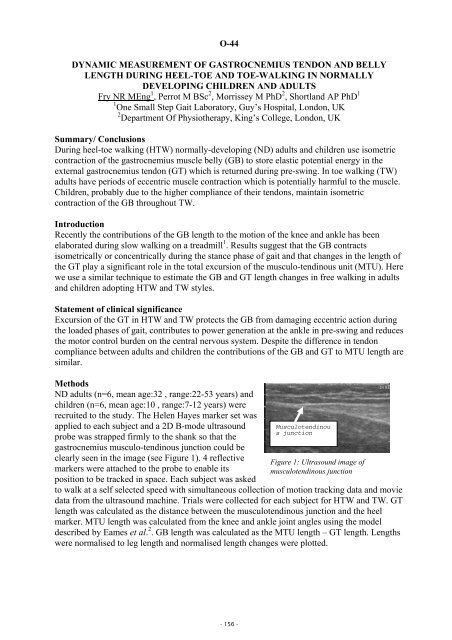1st Joint ESMAC-GCMAS Meeting - Análise de Marcha
1st Joint ESMAC-GCMAS Meeting - Análise de Marcha
1st Joint ESMAC-GCMAS Meeting - Análise de Marcha
You also want an ePaper? Increase the reach of your titles
YUMPU automatically turns print PDFs into web optimized ePapers that Google loves.
O-44<br />
DYNAMIC MEASUREMENT OF GASTROCNEMIUS TENDON AND BELLY<br />
LENGTH DURING HEEL-TOE AND TOE-WALKING IN NORMALLY<br />
DEVELOPING CHILDREN AND ADULTS<br />
Fry NR MEng 1 , Perrot M BSc 2 , Morrissey M PhD 2 , Shortland AP PhD 1<br />
1 One Small Step Gait Laboratory, Guy’s Hospital, London, UK<br />
2 Department Of Physiotherapy, King’s College, London, UK<br />
Summary/ Conclusions<br />
During heel-toe walking (HTW) normally-<strong>de</strong>veloping (ND) adults and children use isometric<br />
contraction of the gastrocnemius muscle belly (GB) to store elastic potential energy in the<br />
external gastrocnemius tendon (GT) which is returned during pre-swing. In toe walking (TW)<br />
adults have periods of eccentric muscle contraction which is potentially harmful to the muscle.<br />
Children, probably due to the higher compliance of their tendons, maintain isometric<br />
contraction of the GB throughout TW.<br />
Introduction<br />
Recently the contributions of the GB length to the motion of the knee and ankle has been<br />
elaborated during slow walking on a treadmill 1 . Results suggest that the GB contracts<br />
isometrically or concentrically during the stance phase of gait and that changes in the length of<br />
the GT play a significant role in the total excursion of the musculo-tendinous unit (MTU). Here<br />
we use a similar technique to estimate the GB and GT length changes in free walking in adults<br />
and children adopting HTW and TW styles.<br />
Statement of clinical significance<br />
Excursion of the GT in HTW and TW protects the GB from damaging eccentric action during<br />
the loa<strong>de</strong>d phases of gait, contributes to power generation at the ankle in pre-swing and reduces<br />
the motor control bur<strong>de</strong>n on the central nervous system. Despite the difference in tendon<br />
compliance between adults and children the contributions of the GB and GT to MTU length are<br />
similar.<br />
Methods<br />
ND adults (n=6, mean age:32 , range:22-53 years) and<br />
children (n=6, mean age:10 , range:7-12 years) were<br />
recruited to the study. The Helen Hayes marker set was<br />
applied to each subject and a 2D B-mo<strong>de</strong> ultrasound<br />
probe was strapped firmly to the shank so that the<br />
gastrocnemius musculo-tendinous junction could be<br />
clearly seen in the image (see Figure 1). 4 reflective<br />
markers were attached to the probe to enable its<br />
position to be tracked in space. Each subject was asked<br />
to walk at a self selected speed with simultaneous collection of motion tracking data and movie<br />
data from the ultrasound machine. Trials were collected for each subject for HTW and TW. GT<br />
length was calculated as the distance between the musculotendinous junction and the heel<br />
marker. MTU length was calculated from the knee and ankle joint angles using the mo<strong>de</strong>l<br />
<strong>de</strong>scribed by Eames et al. 2 . GB length was calculated as the MTU length – GT length. Lengths<br />
were normalised to leg length and normalised length changes were plotted.<br />
- 156 -<br />
Musculotendinou<br />
s junction<br />
Figure 1: Ultrasound image of<br />
musculotendinous junction
















